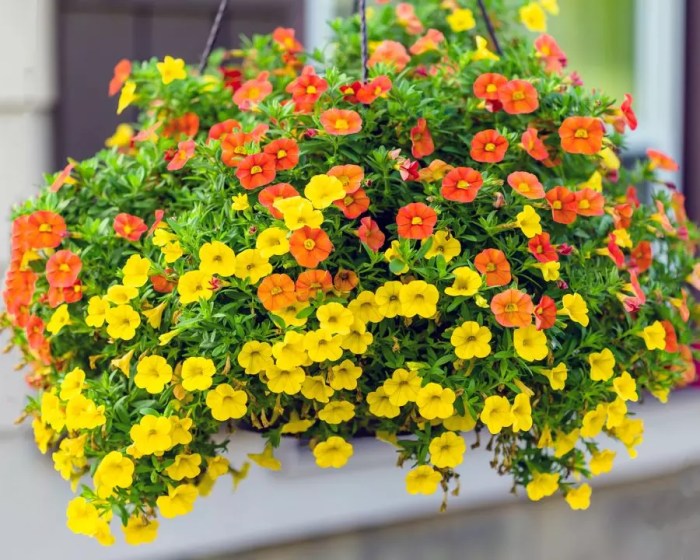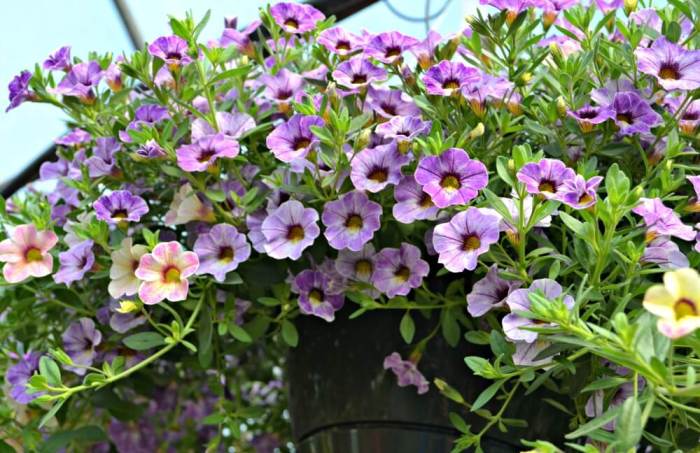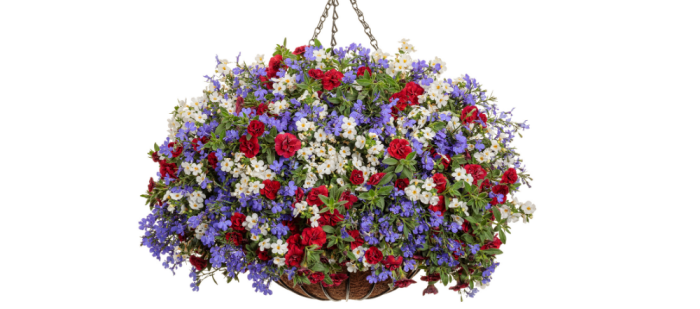Hanging plants that like afternoon sun – Embark on a journey into the realm of hanging plants that revel in the golden rays of the afternoon sun. These verdant wonders add a touch of elegance and vitality to any space, inviting nature’s embrace into your home.
From trailing vines to cascading foliage, discover a curated selection of species that flourish in this unique light environment. Learn the secrets to choosing the perfect hanging basket, ensuring optimal soil conditions, and providing meticulous care for your sun-loving plants.
Suitable Plant Species

Hanging plants that thrive in afternoon sun possess specific adaptations to tolerate the intense and direct sunlight during this period. These plants exhibit varying degrees of light requirements and tolerances, making it crucial to select species that are well-suited to this environment.
The following list provides a comprehensive guide to hanging plants that excel in afternoon sun:
Suitable Species
- Spider Plant (Chlorophytum comosum): Thrives in bright, indirect light, including afternoon sun, but can tolerate lower light conditions.
- Burro’s Tail (Sedum morganianum): Requires ample sunlight, including afternoon sun, to maintain its plump and succulent leaves.
- String of Pearls (Senecio rowleyanus): Prefers bright, indirect light but can handle some direct sunlight, including afternoon sun.
- Zebra Haworthia (Haworthia fasciata): Enjoys bright, indirect light but can tolerate some afternoon sun exposure.
- Portulacaria Afra (Dwarf Jade Plant): Thrives in full sun to partial shade, including afternoon sun, and is drought-tolerant.
Hanging Basket Selection

Hanging baskets offer a versatile solution for showcasing plants that thrive in afternoon sunlight. When selecting the ideal baskets for these plants, consider both material and size to ensure optimal growth and aesthetic appeal.
Material
Choose baskets made from durable materials that can withstand outdoor conditions and provide adequate drainage. Wicker, wire, and plastic are all suitable options. Wicker baskets add a natural touch, while wire baskets provide excellent drainage and air circulation. Plastic baskets are lightweight and easy to clean.
Size
The size of the basket should be appropriate for the plant’s root system. A general rule of thumb is to choose a basket that is at least 10 inches in diameter for every 12 inches of plant height. Larger plants may require baskets up to 18 inches in diameter.
Drainage and Aeration
Proper drainage is essential to prevent root rot. Ensure the basket has multiple drainage holes at the bottom to allow excess water to escape. Additionally, choose baskets with open sides or mesh panels to promote air circulation and prevent waterlogging.
Soil and Nutrient Requirements
For hanging plants thriving in afternoon sun, the ideal soil composition is crucial for optimal growth. Well-draining, nutrient-rich soil with a pH range of 6.0 to 6.5 provides the ideal environment for their roots.
Hanging plants that prefer afternoon sun, such as trailing succulents and hoyas, can add a touch of greenery to sunny balconies and patios. For those with shaded areas, consider hanging plants that thrive in low light, such as ferns, pothos, and spider plants.
Hanging plants for shade can bring life and freshness to any room, creating a serene and inviting atmosphere. Returning to the topic of afternoon sun, trailing begonias and lantanas are excellent choices for hanging baskets, offering vibrant blooms that attract pollinators.
To ensure a thriving environment, organic matter like peat moss or compost should be incorporated into the soil mix. This helps retain moisture while enhancing drainage and aeration. A slow-release fertilizer specifically formulated for hanging plants can be applied during the growing season to provide sustained nutrient availability.
Fertilizers and Amendments
- A balanced, water-soluble fertilizer with an NPK ratio of 10-10-10 or 20-20-20 can be applied monthly during the growing season.
- Epsom salts, a source of magnesium and sulfur, can be added to the soil every few months to promote lush foliage.
- Bone meal or blood meal can be incorporated into the soil to provide additional phosphorus and nitrogen, respectively.
Watering and Maintenance: Hanging Plants That Like Afternoon Sun

Maintaining healthy hanging plants in afternoon sun requires careful attention to watering and other maintenance practices. Watering frequency depends on factors such as plant type, pot size, and weather conditions. Pruning, fertilizing, and pest control are also essential for optimal plant growth.
Watering Techniques
Water hanging plants thoroughly, allowing excess water to drain from the drainage holes. Allow the top inch or two of soil to dry out before watering again. During hot, dry weather, plants may need to be watered daily or even twice a day.
Hanging plants that thrive in the warm glow of the afternoon sun require specialized care. For those seeking stylish and practical solutions, Bunnings offers an extensive range of plant hanger bunnings . These hangers provide secure support while allowing ample airflow, promoting healthy growth for plants that prefer indirect sunlight.
Whether you’re an experienced gardener or just starting out, Bunnings has a variety of hanging plants that will add a touch of greenery and charm to your home.
In cooler weather, watering frequency can be reduced to once or twice a week.
Pruning
Regular pruning encourages bushier growth and removes dead or damaged foliage. Use sharp, clean shears to prune stems back to a healthy node or leaf. Pruning can also be used to control plant size and shape.
Fertilizing
Fertilize hanging plants every two to three weeks during the growing season with a balanced liquid fertilizer diluted to half strength. Avoid over-fertilizing, as this can damage plants.
If you’re seeking hanging plants that thrive in the warm glow of the afternoon sun, consider varieties such as the Bird of Paradise, Philodendron, and Spider Plant. These verdant wonders bring a touch of nature indoors, creating a vibrant atmosphere.
For more hanging plant inspiration, explore our comprehensive guide hanging plants to enhance your home with these botanical beauties.
Pest Control
Monitor hanging plants regularly for pests. Common pests include aphids, spider mites, and mealybugs. Treat infestations promptly with an appropriate insecticide or pesticide. Encourage beneficial insects, such as ladybugs and lacewings, to help control pests naturally.
Aesthetic Considerations
Hanging plants that thrive in afternoon sun add a touch of greenery and visual interest to any outdoor space. Their cascading foliage and vibrant blooms create a dynamic display that can transform a patio, balcony, or garden.
When arranging hanging plants in afternoon sun, consider the visual impact they will have. Choose plants with complementary colors and textures to create a harmonious display. For example, pair a trailing plant with variegated leaves with a flowering plant in a contrasting color.
You can also create a vertical garden by hanging plants at different heights.
Color Combinations
To create a visually appealing arrangement, consider the color combinations of the plants you choose. Warm colors, such as red, orange, and yellow, create a vibrant and cheerful display. Cool colors, such as blue, green, and purple, create a more calming and serene atmosphere.
- Red and yellow flowers create a striking contrast that is sure to catch the eye.
- Blue and white flowers create a tranquil and inviting atmosphere.
- Purple and green foliage creates a rich and sophisticated look.
Texture and Form, Hanging plants that like afternoon sun
In addition to color, the texture and form of the plants you choose can also affect the overall look of your arrangement. Plants with large, bold leaves create a dramatic statement, while plants with smaller, delicate leaves create a more subtle and refined look.
- Trailing plants with long, flowing stems add a sense of movement and drama to your arrangement.
- Plants with upright growth habits create a more formal and structured look.
- Plants with variegated foliage add a touch of interest and complexity to your arrangement.
Ultimate Conclusion

Whether you seek to create a lush indoor oasis or enhance your outdoor living space, hanging plants that thrive in afternoon sun offer endless possibilities. Embrace the beauty of nature and bring the warmth of the sun indoors with these captivating companions.
FAQ Insights
What are the benefits of hanging plants in afternoon sun?
Hanging plants in afternoon sun provide natural air purification, enhance humidity levels, and add a touch of greenery to brighten up any space.
How often should I water hanging plants in afternoon sun?
Water hanging plants thoroughly when the soil feels dry to the touch, typically every 2-3 days during the growing season.
What is the best type of soil for hanging plants in afternoon sun?
Use a well-draining potting mix specifically designed for container gardening, ensuring adequate drainage to prevent root rot.